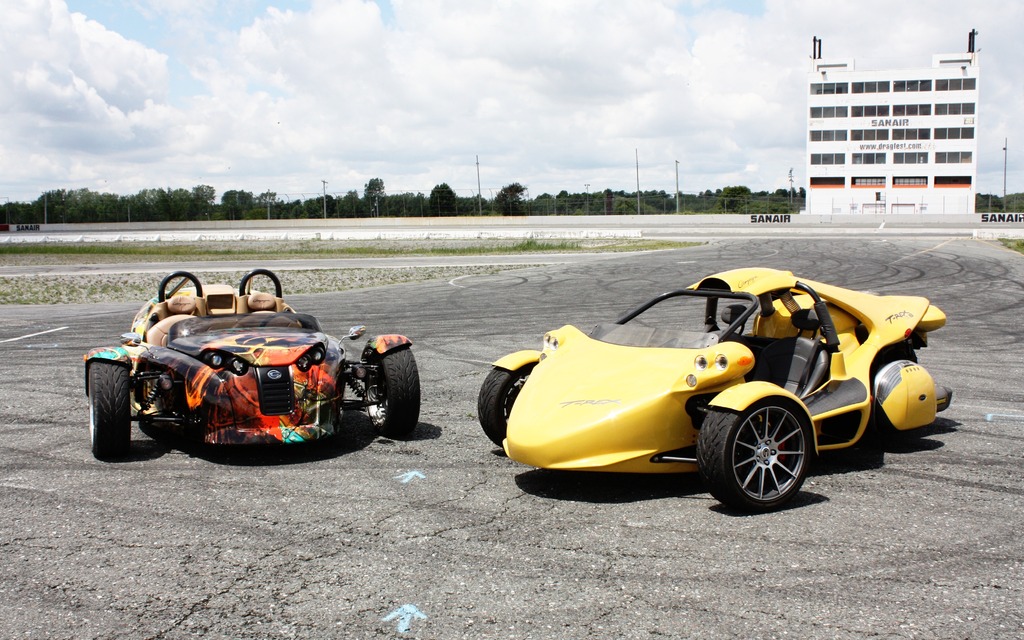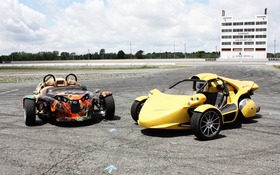Campagna T-Rex 16S and V13R: Two Speedsters, Two Personalities
Chances are, you’ve seen the T-Rex before. It’s that little three-wheeler that looks like a cross between a car and a sport bike, easily recognizable by its bold style and low profile. The T-Rex is the creation of Daniel Campagna, who officially started producing it in 1994. Back then, the T-Rex was only sold in Quebec and classified as a motorcycle. After Campagna Motors ran into financial trouble, it was bought in 2008 by two businessmen who brought new energy to the company and added a second model, the V13R.
These days, Campagna models are built in Boucherville, just outside of Montreal. They’re sold around the world thanks to a more widespread network of dealers. The T-Rex 16S and V13R are built entirely by hand and the company assembles four or five units per week. These vehicles became a much easier sell when a change in legislation allowed them to be classified as touring vehicles, meaning that owners wouldn’t have to have a motorcycle license.
- Also: Three-Wheeled Vehicles: Insurance, Savings and Choices
- Also: Polaris Aims For The Future With The Slingshot
T-Rex 16S: Formula 1
The original, the T-Rex 16S, is easy to spot with its V-shaped front end, its aerodynamic accessories, its tiny roof equipped with an intake to draw fresh air into the engine, and body that rises over the back wheel. You’d be hard pressed to come up with a more intimidating style! Eight basic colours are available for the body, which is made of fibreglass and rests on a tubular frame that is welded and assembled at the plant.
New this year is the 16S equipped with the P Package for enhanced style and performance. Actually, this is the model that really won us over. It includes an adjustable Stage 5 suspension, ventilated and grooved disc brakes, red brake calipers and distinct 16-inch wheels. The treatment is just as sweet on board with the addition of a black suede Sparco steering wheel and uniquely textured seats featuring the P emblem. The 16S we tested also came with an Akrapovic muffler, as well as side saddle bags to step up the model’s practicality. Each offers approximately 46 litres of storage space, in addition to being water-tight and removable for use as a suitcase of sorts.
Once you slide aboard (a move that requires a certain degree of flexibility), you realize just how low the vehicle is. Your backside is literally centimetres from the ground! The mechanical components reinforce the impression of driving a race car. We loved it! We also noted the little details, such as carbon fibre accents and the instrumentation that presents the information clearly. The controls for the onboard computer and sound system—yep, the T-Rex comes with a 180-watt Alpine system—are grouped together in a pod located within easy reach.
The T-Rex 16S features an engine launch button made by BMW. The engine itself is a 1650-cc inline-6 that produces 160 horsepower and 129 lbs.-ft. of torque. It’s paired with a six-speed sequential gearbox. We especially enjoyed the purr of the engine, which is relatively quiet at low revs but becomes more pronounced in sporty driving.
Once in motion, the T-Rex will surprise you with its forceful acceleration. Darting from 0 to 100 km/h takes just 3.9 seconds, while the super short distance between the gears on the sequential gearbox keeps you pinned to your seat. Drivers need to take care, however, to prevent the rear train from drifting or oversteering, as the T-Rex doesn’t come with any electronic traction control systems. This goes counter to current trends—and it’s oddly refreshing. The 16S lets the driver feel in control again—something that many cars no longer do—and lets drivers show off their skills.
The only system that adjusts the T-Rex’s handling is an electronic selector with three modes: Dynamic, Highway and Rain. The latter modulates the power curve to facilitate driving in slippery conditions. On the track, the steering is so precise that you can guide the 16S with your fingertips and position it appropriately in corners. With a very low centre of gravity and firm suspension, there’s almost no weight transfer. The vehicle sticks to the road, provided you keep your cool when turning. Push it too hard into a corner and the front will start to understeer, a sign that you’ve reached the limit. In fact, the T-Rex handles a lot like a small Formula car. Not bad for a machine built for the highway!
Overall, the T-Rex 16S surprised us with its refinement and comfort. It’s pleasant for a simple outing and vicious on the track.
V13R: The hot rod
Sold since 2011, the V13 looks more like a classic roadster, with a square front end and open configuration. As the brand’s bad boy, it takes us back to an era of times gone by. The front wheels enhance its design, as do the projector-style headlamps. The V13R is fearsome!
Just behind the passenger compartment is a liquid-cooled Harley-Davidson 60-degree V-twin engine. This mill works with a five-speed sequential gearbox to transmit power to the single rear wheel, which also happens to be the pièce de resistance in this vehicle’s bold style. This tire’s unique dimensions are 295/35ZR18.
The V13R’s interior is a lot more simplistic than that of the T-Rex 16S. There’s no radio, no launch button, no digital screen. All you get is a steering wheel, indicator lever and instrumentation pod in the middle of the dashboard. We would have liked to have seen a few more trimmings, but we also understand the designer’s goal of preserving the model’s classic style. Oh, but at least there’s a glove compartment!
Thanks to the adjustable seat and pedals, finding a good driving position is a cinch. The advantage of the V13R over the T-Rex is that there’s no roof, which means unlimited headroom for taller folks. Once the Harley-Davidson engine kicks into action, the driver is treated to a rich rumble well controlled by the exhaust. There’s none of that offensive noise you get from some motorbikes. Turn the key in the ignition, release the hand brake, engage first gear, ease off the clutch and... the engine chokes. Ok, so we quickly realized that this speed machine was not conventional in any way and that its clutch is a lot higher than the T-Rex’s. Once we became familiar with its specific workings, we loved the V13R, its open top and comfortable ride. With 125 horsepower, it offers a little less power, but its acceleration is nonetheless vigorous. Generally speaking, however, it doesn’t aspire to the same level of sport performance as the T-Rex.
On the highway, this vehicle is a little noisier than the T-Rex, but visibility is better as there is no roof or tubular cage. While we felt safe, the low position of these models made us worry about how well other vehicles could see us. We made a point of spending as little time as possible in their blind spots!
In short, the V13R and T-Rex 16S have two distinct personalities and will appeal to different clienteles. Campagna Motors serves up two unusually interesting and well-designed vehicles—but with a starting price of $53,999, they won’t fit all budgets!












